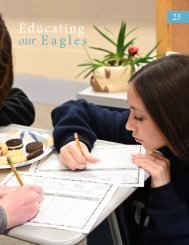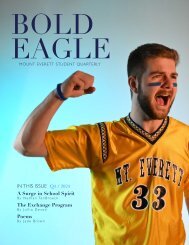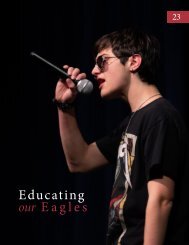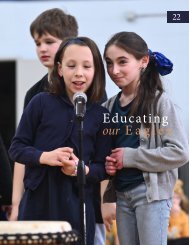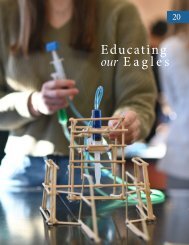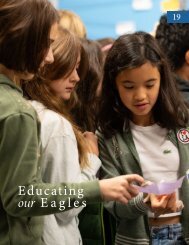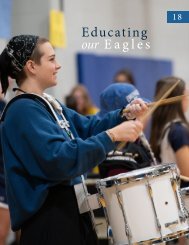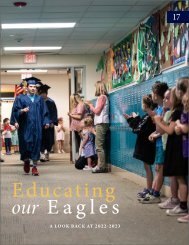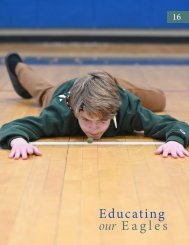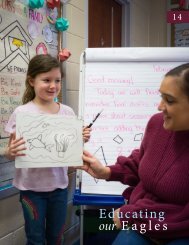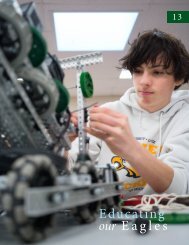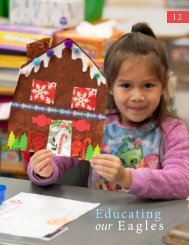Educating Our Eagles - 11/2021
A publication of the Southern Berkshire Regional School District. Once a month we will be highlighting our students and teachers as they work together to grow and learn. The goal of this newsletter is to provide you with a window into our day-to-day experiences and an opportunity to see into our classrooms. Each day we strive to create interactive and highly engaging lessons that support and inspire all learners.
A publication of the Southern Berkshire Regional School District.
Once a month we will be highlighting our students
and teachers as they work together to grow and learn.
The goal of this newsletter is to provide you with a
window into our day-to-day experiences and an
opportunity to see into our classrooms. Each day we
strive to create interactive and highly engaging lessons
that support and inspire all learners.
- TAGS
- instruction
- educating
You also want an ePaper? Increase the reach of your titles
YUMPU automatically turns print PDFs into web optimized ePapers that Google loves.
Educating
our Eagles
EDUCATING OUR EAGLES
1
CONTENTS
4
Introduction - Curriculum Director, Julie Dolan
6
6
8
10
Middle School Visual Arts - Visual Art teacher,
Stephanie Graham
Middle School English Language Arts - English
teacher, Julie Barros
Ninth grade Independent Reading Ads - English
teacher, Kevin Wolgemuth
11
12
14
17
16
Tenth Grade Transition from Korean Dynasties
to Feudalism in Japan - Social Studies teacher,
Alex Izatt
First Grade Tradition Studies - First grade
teacher, Christina Carlson
The Incredible Journey/Storm Water Runoff
Simulation - Fifith grade teacher, Claudine
Mallory
Three Act Tasks - Third grade teacher, Jane
Schur
Tenth Grade Centroid Studies - Science and
math teacher, Timothy Schwartz
8
10
EDUCATING OUR EAGLES
2 EDUCATING OUR EAGLES 3
INTRODUCTION
From SBRSD’s Director of Curriculum
and Instruction, Julie Dolan
Julie Dolan
Director of Curriculum
and Instruction
Welcome to our first edition of
“Educating our Eagles.”
Our vision at Southern
Berkshire Regional School
District is to provide a
rigorous educational environment that prepares
and inspires all students to be resilient, curious, and
ethical global citizens who embrace the challenges
of an ever-changing world through a commitment
to our core values of opportunity, excellence,
character, and community.
Once a month we will be highlighting our students
and teachers as they work together to grow and learn.
The goal of this newsletter is to provide you with a
window into our day-to-day experiences and an
opportunity to see into our classrooms. Each day we
strive to create interactive and highly engaging lessons
that support and inspire all learners.
Monthly, we will post this newsletter to our District
webpage at www.sbrsd.org. It will contain a sampling
of what our students experienced this past month,
including the student goals and the teacher’s
observations of the lessons. Many thanks to Ms. Kari
Giordano for all the work she has put into designing
this beautiful document.
Please feel free to contact me jdolan@sbrsd.org any
time you have questions or would like to discuss
curriculum. I am always available.
EDUCATING OUR EAGLES
4 EDUCATING OUR EAGLES 5
MIDDLE SCHOOL
Visual Arts:
PICASSO PORTRAITS
Description:
Using the reduction process in printmaking, sixth grade students create an abstract
portrait inspired by Pablo Picasso.
Student Learning Goals/Outcomes:
As a result of instruction, students will...
• apply knowledge of Cubism in the abstraction of facial features and the human head.
• learn how to create a 3-part reduction print.
• use the reduction process to print an abstract portrait composition, focusing on the
elements and principles of line, shape, and pattern.
Review:
Students really enjoyed the reduction print process. They were excited by the materials,
and understood how critical it was to follow the procedures. After demonstration, students
practiced how to draw a realistic human head and face. They enjoyed making the final
portrait an abstraction, and drew from the lesson about Picasso where they saw his
evolution of style and technique in portraiture.
EDUCATING OUR EAGLES
6 EDUCATING OUR EAGLES 7
MIDDLE SCHOOL:
CHECK OUT 6TH GRADE RAP VIDEOS:
www.youtube.com/watch?v=aUz0ABRf0g8
English Language Arts:
PARTS OF SPEECH RAP
Description:
Sixth grade students are to use the eight parts of speech learned in class in a creative,
original rap. They can choose to work in a small group, partners or alone.
Student Learning Goals/Outcomes:
As a result of instruction, students will be able to...
• create a rap whereby they name the eight parts of speech correctly
• use each part of speech and give examples
• create end rhyme
• perform and articulate in front of the class
Review:
Students not only had fun with this project but they exhibited bravery by performing in
front of their peers. Students did a great job memorizing the eight parts of speech but
struggled with creating rhyming words and patterns without the help of a computer.
MA Frameworks
CCSS.ELA SL1, 5; L1
EDUCATING OUR EAGLES
8 EDUCATING OUR EAGLES 9
HIGH SCHOOL:
Ninth grade Independent Reading Ads
After selecting and
reading a novel independently,
ninth
grade students wrote a
sixty-second review to
sell the novel on radio.
Anonymous first drafts were shared onscreen
for peer critique and to generate
a list of best practices and corrections.
Second drafts were revised and refined
for impact. Students also created a visual
ad with a selected quote from their independent
reading.
As a result of instruction, students
will be able to:
• Demonstrate knowledge through summary
and review at the end of selfpaced
reading
• Peer critique to establish best practices
and norms
• Generate rules of recorded public
speaking
• Deliver work spanning two forms of
public media.
Observations:
Although many students enjoyed the
opportunity to read for the pleasure of
reading, some students can focus on
developing motivation, time management
and other self-regulating skills.
Particularly useful was for students to
review anonymous peer work on-screen,
identifying successes as well as mistakes
that became an editing checklist for their
own work. Students who are uncomfort-
able with front-of-class public speaking
appreciated the opportunity to record
audio.
Anchor standards:
Reading 2: Determine central ideas or
themes of a text and analyze their development
(47)
Reading 10: Read and comprehend
complex literary texts independently
and proficiently (47)
Writing 2: Write informative/explanatory
texts to examine and convey complex
ideas (53)
Writing 4: Produce clear and coherent
writing in which the development, organization
and
style are appropriate
to task,
purpose and
audience (53)
Writing 6: Use
technology ...
to produce and
publish writing
and to interact
with others (53)
Speaking and
Listening 1:
Prepare for and
participate effectively in a range of conversations
(60)
Speaking and Listening 6: Adapt speech
to a variety of contexts and communicative
tasks (60)
W
e start off with
an activator on
a map of the Korean
peninsula.
Tenth grade students
labeled the
blank map of Korea with the 3 kingdoms
we discussed in the previous class. Next,
I introduced our supporting question for
the lesson: “How has Korea served as both
a cultural bridge and a battleground between
China and Japan?”. Once we have a
discussion about our supporting question
we transitioned into a slide-show on our
new content (Feudalism in Japan). Each
student receives an outlined version of
the notes they fill out on their own as we
go. Once we get to the societal structure
of Japan’s feudal age the students fill out a
pyramid of the social hierarchy (Emperor,
shogun, samurai, etc.). After the pyramid
we watched a Ted Ed of “A Day in the
Life of a Samurai”. We discussed the video
and moved onto our Exit Ticket, a guided
reading about the new content they’ve received
during the lesson.
As a result of instruction,
students will be able to:
• Be able to access prior knowledge on
the geography of the Korean peninsula
• Be able to understand the relationship
Korea & Japan have together.
• Be able to explain Feudalism in Japan,
including details on the social hierarchy
as well as the characteristics of the
samurai
Observations:
Students enjoyed filling out the map and
the pyramid diagram. Students enjoyed
the video on the samurai and enjoyed
when I lectured on the samurai’s characteristics
(weapons, armour, Bushido,
seppuku, etc.). Students were not so enthralled
with lecturing on the semantics
of Japanese society during the Feudal Age.
Frameworks:
HIGH SCHOOL
Transition from Korean Dynasties
to Feudalism in Japan
Physical and political geography of East
Asia [7.T2a]
On a political map of the region, demonstrate
map reading skills to distinguish
countries, capitals, and other cities and
to describe their absolute location and
relative location (relationship to other
countries, cities, or bodies of water); use
knowledge of maps to complement information
gained from text about a city,
country or region
c. Ancient Japan and Korea, c.300 BCE–
1300 CE [7.T2c] Supporting Question:
How has Korea served as both a cultural
bridge and a battleground between China
and Japan?
The Kamakura Shogunate (c. 1185–1333
CE) in Japan, feudal military rule, invasions
of the Mongol Empire, restoration
of temples destroyed in war, Buddhist
sculpture, calligraphy influenced by Zen
Buddhism
EDUCATING OUR EAGLES
10 EDUCATING OUR EAGLES 11
ELEMENTARY SCHOOL:
First Grade Tradition Studies
The first-grade celebrated traditions by learning about the Macy’s
Thanksgiving Day Parade and how it came to be. Many employees at
Macy’s were immigrants and missing their homeland, so the parade
originated to celebrate all the different cultures and traditions. The
students shared their own traditions and did STEM activities with
marionettes and balloons.
District wide Pre-K-2, the FUNdations phonics program is being used to provide
systematic, explicit phonics instruct, a core skill needed for reading and writing.
Observations:
Students were engaged in traditions activity, were able to compare traditions in
stories to their own traditions. Students are applying skills in FUNdations in their
every day writing and making growth.
EDUCATING OUR EAGLES
12 EDUCATING OUR EAGLES 13
ELEMENTARY SCHOOL:
The Incredible Journey
Storm Water Runoff Simulation
Description:
Incredible Journey: In the Incredible Journey, fifth graders pretend that they are droplets
of water and go through a series of stations based on the roll of a die. As they travel to
each station they collect a bead to make a bracelet. The stations include Cloud, Animals,
Plants, Stream, Soil, Ocean, Mountain, Glacier, and Rivers. Depending on the number
that they roll, they either stay in that station and collect a bead or journey to another
station and collect a new bead there. This simulation helps students to understand how
water travels around the earth.
Storm Water Runoff Simulation: In this lesson students work in small teams with storm
drain models to simulate how our water is most commonly polluted today. Then students
learn about and apply innovative technologies, like roof top gardens and porous asphalt to
help lessen the amount of pollution that ends up in their storm drain.
Student Learning Goals/Outcomes:
As a result of instruction, students will be able to...
• use a model to describe the cycling of water through a watershed through
evaporation, precipitation, absorption, surface runoff and condensation.
• obtain and combine information about ways communities can reduce the human
impact on earth’s resources.
Review:
Students were highly engaged and participatory in both simulations.
EDUCATING OUR EAGLES
14 EDUCATING OUR EAGLES 15
HIGH SCHOOL:
What is a centroid?
or How to find the center of gravity
of a triangle.
ELEMENTARY SCHOOL:
Third Grade Math
Three Act Tasks
Mr. Schwartz’s
tenth grade Geometry
students
were taught to
mathematically
find the center of
any triangle. Student proved their findings by
balancing it on their fingers.
As a result of instruction, students will be
able to:
• calculate the centroid of any triangle.
• Find medians of the segments.
• Discover the centroid divides each median in the
ratio 2:1
Observation:
Students began to discover that one really must only find
where two of the medians intersect to find the center of
gravity since the medians only intersect at one point.
Third grade classes recently did a 3 act task that
required students to figure out how many chocolate
chips were used in a recipe. They needed
to estimate, ask questions ,and problem solve in
groups. Part way through the lesson, they were
given additional information and then expected
to come up with an answer. The students really enjoyed working
together and problem solving.
Student learning outcomes:
• problem solving
• questioning
• multiplication
• addition
• working in groups
Observation:
The students were very engaged and asked great questions.
They loved the open ended process and were able to articulate
not only what their guess was, but how they came to arrive at
their answers.
EDUCATING OUR EAGLES
16 EDUCATING OUR EAGLES 17
EDUCATING OUR EAGLES
18




